:max_bytes(150000):strip_icc():format(webp)/GettyImages-185223738-56a691fd5f9b58b7d0e3a1d9.jpg)
Powerpoint Supported Video Format and Advanced User Tips for 2024

Powerpoint Supported Video Format and Advanced User Tips
It doesn’t matter if you are a student or a working person; you must have made a PowerPoint presentation in your life. It can be a business presentation, educational presentation, or any work-related presentation if you are an employee. The types of presentation may vary, but the way to make a presentation is almost the same.
We are here to share a few tips and tricks to make your presentations unique like, you can add videos, voice-overs, and much more things. Remember one thing; there are certain video formats that PowerPoint supports. The video formats for PowerPoint presentations are discussed below, read ahead, and you’ll know more about them.
In this article
01 Overview of PowerPoint Supported Video Format
02 How to Insert or Embed Video in PowerPoint?
03 How to Turn Your Presentation into A Video with PowerPoint?
04 How to Match Color and Remove Image Background in PowerPoint?
Part 1. Overview of PowerPoint Supported Video Format
The supported video formats for PowerPoint are different for both Windows and macOS. All the supported formats for both types of the operating system are discussed below individually:
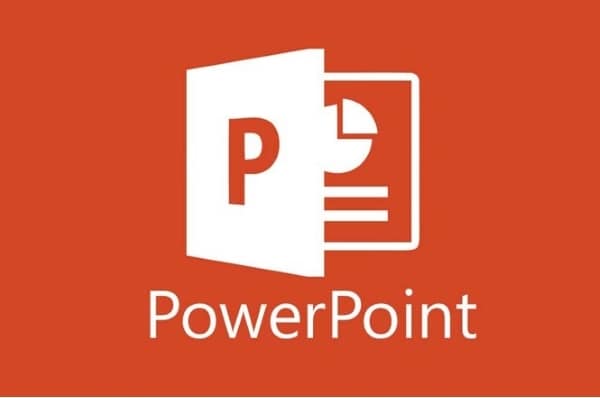
Windows
ASF: Advanced System Format (ASF) is a proprietary video and audio container format. It is an extensible file format design.
AVI: AVI is an Audio Video Interleave file. It is a multimedia container format made by Microsoft. It allows synchronous audio with video playback.
MP4, M4V, MOV: MPEG-4 file format is also known as MP4 or M4V. It is a common video file format. In comparison, MOV is developed by Apple Inc. It is the same as MP4 but is made for Apple devices.
MPEG, MPG: It is a famous file format for movies that are distributed over the internet. They use specific compression that makes downloading and steaming easy and fast.
WMV: WMV was introduced by Microsoft, and it stands for Windows Media Video. It is a compressed file container. The format is based on ASF.
macOS
AVI, VFW: AVI stands for Audio Video Interleave, and VFW stands for Video for Windows. Both are multimedia container files. AVI is encoded into VFW.
MP4, MPEG-4: MP4 is a digital video file format. MPEG-4 uses compression, but it is less common than the MP4 extension. MPEG encodes audio tracks.
M4V: It is a video container format developed by Apple Inc. It is similar to MP4. MV4 is used to encode video files in iTunes.
MPG, MPEG, MPE, M75, M15: MPG, MPEG, MPE, M75, and M15 are all the different types of formats developed by the Moving Pictures Expert Group.
M2V: It contains only video data and no other files. It is encoded by using MPEG-2 compression. It is mostly used by DVD authorized applications.
TS: It is a Video Transport Stream file and is used to store MPEG-2 compressed video data. It is used by digital broadcasting systems.
MOV, QT: QT and MOV both were developed by Apple Inc. Both the formats can hold multiple types of multimedia formats (audio, video, and subtitles).
DIF: DIF stands for Data Interchange Format. It is a text-based file format and is used for tabular and spreadsheet data. It is also used to transfer data between spreadsheets.
Part 2. How to Insert or Embed Video in PowerPoint?
PowerPoint is the simplest way to make a presentation. You might impress your boss with a good presentation. Do you ever consider adding videos from your computer across your slides? Have you ever embedded a video in PowerPoint? Allow us to help you out with this. The process to insert or embed a video in PowerPoint is not difficult; you can do this in a few simple steps.
How to Insert a Video in PowerPoint
The video format for PowerPoint differs for different versions. The steps to insert a video in PowerPoint do not deviate much. You can follow the following instructions and insert the video:
Step 1: First, you need to select the slide in which the video is supposed to be inserted. Select the video from the device you are using by heading to the ‘Insert’ tab. There, look for the ‘Video’ option and click on it to select the ‘This Device’ option.
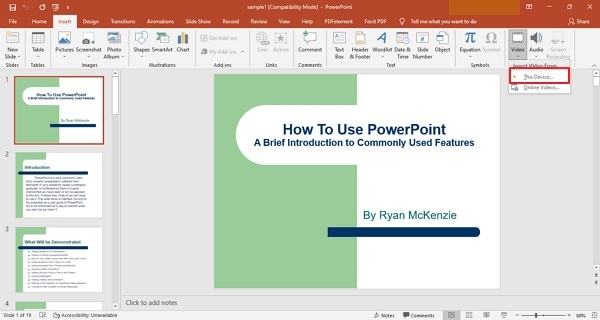
Step 2: After you have located and selected the video, click on ‘Insert.’ Adjust the video settings from the ‘Format’ and ‘Playback’ toolbar according to your needs. You can resize the video, add effects, play full screen, etc.
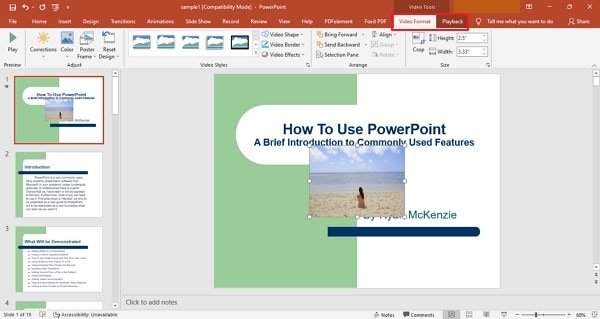
Step 3: After all the settings are done, you need to preview the slideshow to check if the video is playing according to your desire or not.
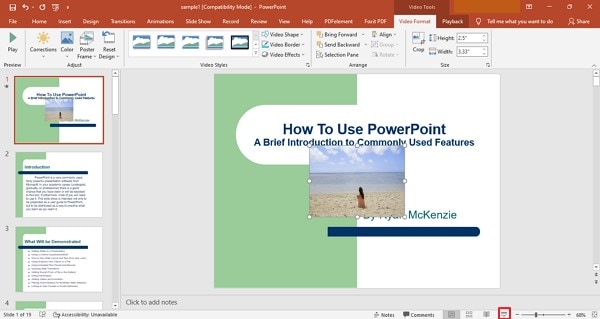
How to Embed a Video in PowerPoint
If you are looking to add an online video across PowerPoint, the platform allows you to either embed its code or use its URL for adding it within your slides. To follow this, look into the steps featured below.
Step 1: Access the online video across your browser that you wish to embed in your PowerPoint slides. You can either copy its embed code or simply copy its URL. However, this video can only be from YouTube, SlideShare, Vimeo, Stream, or Flipgrid, as allowed by PowerPoint.
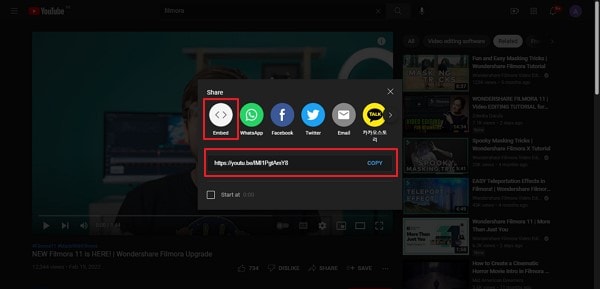
Step 2: Once copied, open your slides, and navigate to the “Insert” panel. Select “Video” from the available options and proceed to click on “Online Videos.”
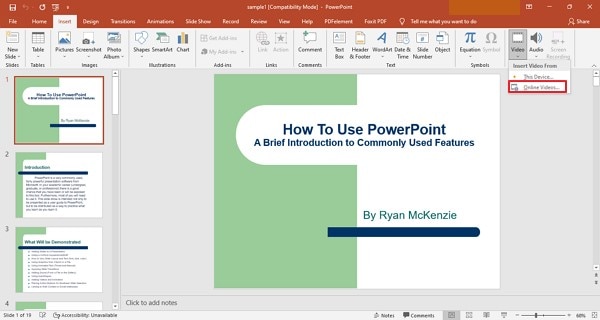
Step 3: A new window opens up. Paste the copied code or URL across the provided space and tap “Insert” to add the online video across your slides. You can enhance the video across the “Video Format” and “Playback” sections.
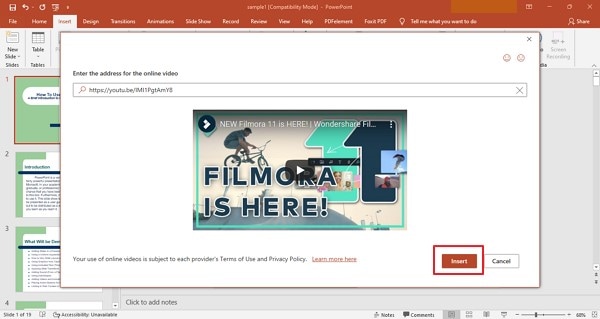
Part 3. How to Turn Your Presentation into A Video with PowerPoint?
Inserting videos in PowerPoint presentations is normal; now, it’s time to discover something new. Have you ever thought of making a PowerPoint presentation a video itself? It is interesting! Your superior authority might get impressed and give you a promotion; who knows.
How to save your presentation as a video in PowerPoint? It can be done in a few simple steps. These steps are concisely discussed in the section below; follow to help yourself.
Step 1: You need to save the presentation that you made at first. After saving the original file, you need to click on ‘Export’ from the main menu.

Step 2: From the ‘Export’ menu, click on the ‘Create Video’ option. Select the video quality as per your needs. You can use pre-recorded narrations with the timings. In case no recorded narrations exist, you can record your own.
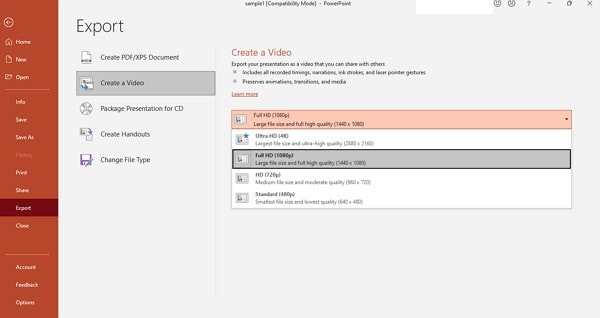
Step 3: The recorded narration will play over your video. If you don’t want narrations, you can simply skip these settings and move on.
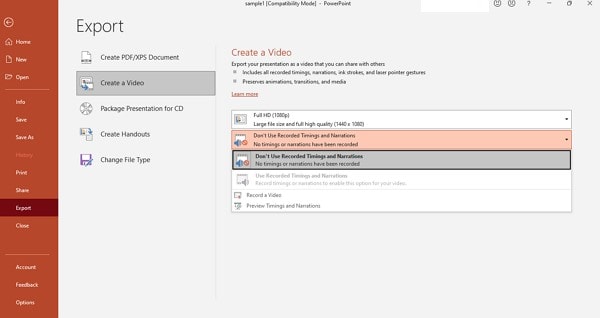
Step 4: Next step is to select how much time a single slide will be shown. Keep in mind the longest slide; select an appropriate time so that all the material in the slides can be read easily.

Step 5: Now, moving towards the final step, click on ‘Create Video.’ This will generate and save the new PowerPoint video on your respective device.
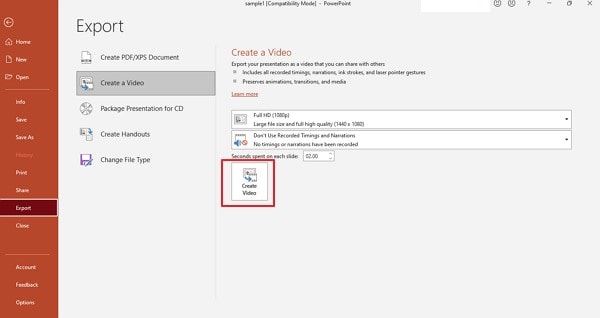
Part 4. How to Match Color and Remove Image Background in PowerPoint?
There are two different things that you can do to make your presentation better. These are distinctive concerning video format for PowerPoint. Removal of background in PowerPoint is discussed, followed by Color Matching.
Remove Image Background
A simple way to remove background in PowerPoint is discussed in the following steps, read them for further assistance:
Step 1: Start by opening the PowerPoint software. Afterward, move to the ‘Insert’ tab and hit the ‘Pictures’ option to insert the image you plan to work with. As you click the photo, the ‘Picture Format’ tab will appear on the taskbar. Select the ‘Remove Background’ option on the left-most side below the taskbar.
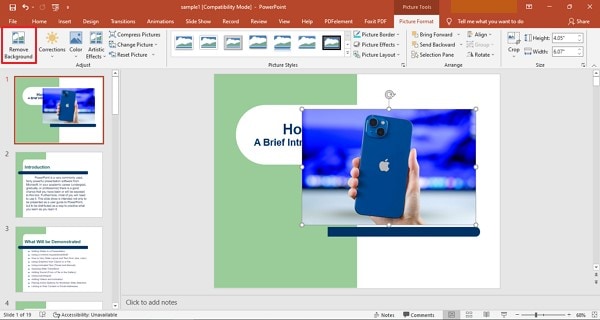
Step 2: When you click ‘Remove Background,’ it will give options. Select the ‘Mark Areas to Keep’ option and draw the section that you want to save. You can also select the option ‘Mark Areas to Remove.’ It depends on the type of photo on which the task is being performed.
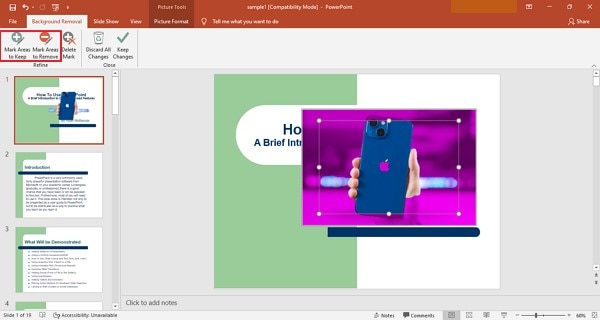
Step 3: Once all the necessary editing is done, click on the option ‘Keep Changes.’ You can save the image separately by clicking on ‘Save as Picture.’
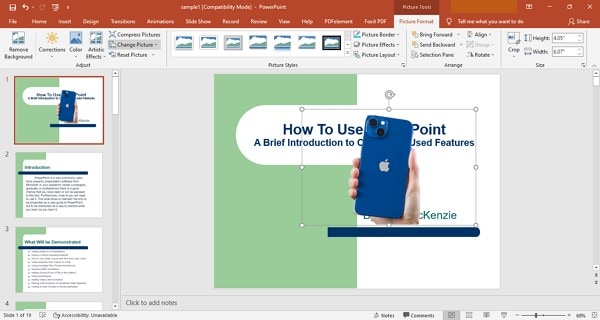
Match Color in PowerPoint
Eyedropper helps you to match colors in your presentation. This takes a few clicks, and you have done color matching.
Step 1: For this, you need to open PowerPoint and select the image that you want to match the color of its background with the rest of the slide. Navigate to the “Design” panel and select the “Format Background” option.
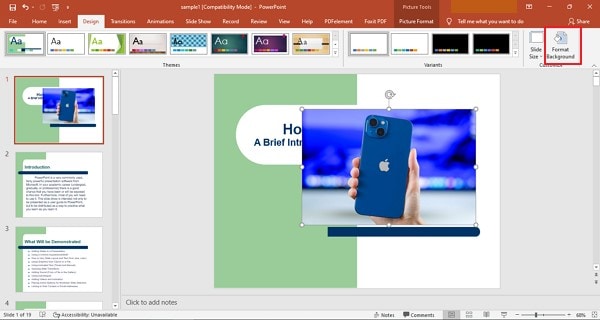
Step 2: Click on ‘Drawing tool’ from the ribbon. Select the option of ‘Solid Fill’ from the menu bar at the top of the screen. Now, from ‘Solid Fill,’ move the mouse towards the ‘Eyedropper’ option. Tap on the background color that you wish to match within the background.
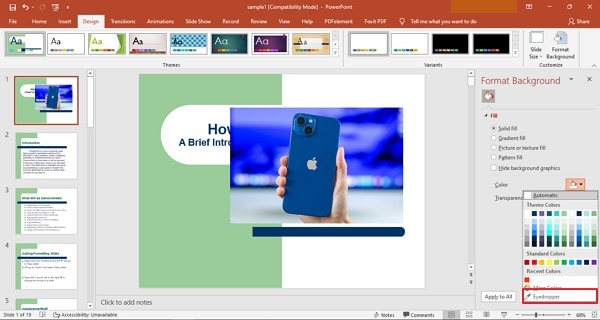
Step 3: Select the area that you want to change the background to its desired color. Access the option of “Solid Fill” after selecting the appropriate section of the document and select the color from the preview window present in the recent colors.

Closing Words
After reading the above article, you will be able to make incredible PowerPoint presentations. As videos add great information to your presentation so hence, we discussed in detail various video formats for PowerPoint. Now let’s share something new.
Do you know anything about Wondershare Filmora ? The software is a video editor with tons of great features and functionalities. You can create stunning videos with Filmora and its wide list of features. The video editor lets you trim, join, cut, split, and do much more than this. You get so many different effects, transitions, and elements with Filmora.
For Win 7 or later (64-bit)
For macOS 10.12 or later
02 How to Insert or Embed Video in PowerPoint?
03 How to Turn Your Presentation into A Video with PowerPoint?
04 How to Match Color and Remove Image Background in PowerPoint?
Part 1. Overview of PowerPoint Supported Video Format
The supported video formats for PowerPoint are different for both Windows and macOS. All the supported formats for both types of the operating system are discussed below individually:

Windows
ASF: Advanced System Format (ASF) is a proprietary video and audio container format. It is an extensible file format design.
AVI: AVI is an Audio Video Interleave file. It is a multimedia container format made by Microsoft. It allows synchronous audio with video playback.
MP4, M4V, MOV: MPEG-4 file format is also known as MP4 or M4V. It is a common video file format. In comparison, MOV is developed by Apple Inc. It is the same as MP4 but is made for Apple devices.
MPEG, MPG: It is a famous file format for movies that are distributed over the internet. They use specific compression that makes downloading and steaming easy and fast.
WMV: WMV was introduced by Microsoft, and it stands for Windows Media Video. It is a compressed file container. The format is based on ASF.
macOS
AVI, VFW: AVI stands for Audio Video Interleave, and VFW stands for Video for Windows. Both are multimedia container files. AVI is encoded into VFW.
MP4, MPEG-4: MP4 is a digital video file format. MPEG-4 uses compression, but it is less common than the MP4 extension. MPEG encodes audio tracks.
M4V: It is a video container format developed by Apple Inc. It is similar to MP4. MV4 is used to encode video files in iTunes.
MPG, MPEG, MPE, M75, M15: MPG, MPEG, MPE, M75, and M15 are all the different types of formats developed by the Moving Pictures Expert Group.
M2V: It contains only video data and no other files. It is encoded by using MPEG-2 compression. It is mostly used by DVD authorized applications.
TS: It is a Video Transport Stream file and is used to store MPEG-2 compressed video data. It is used by digital broadcasting systems.
MOV, QT: QT and MOV both were developed by Apple Inc. Both the formats can hold multiple types of multimedia formats (audio, video, and subtitles).
DIF: DIF stands for Data Interchange Format. It is a text-based file format and is used for tabular and spreadsheet data. It is also used to transfer data between spreadsheets.
Part 2. How to Insert or Embed Video in PowerPoint?
PowerPoint is the simplest way to make a presentation. You might impress your boss with a good presentation. Do you ever consider adding videos from your computer across your slides? Have you ever embedded a video in PowerPoint? Allow us to help you out with this. The process to insert or embed a video in PowerPoint is not difficult; you can do this in a few simple steps.
How to Insert a Video in PowerPoint
The video format for PowerPoint differs for different versions. The steps to insert a video in PowerPoint do not deviate much. You can follow the following instructions and insert the video:
Step 1: First, you need to select the slide in which the video is supposed to be inserted. Select the video from the device you are using by heading to the ‘Insert’ tab. There, look for the ‘Video’ option and click on it to select the ‘This Device’ option.

Step 2: After you have located and selected the video, click on ‘Insert.’ Adjust the video settings from the ‘Format’ and ‘Playback’ toolbar according to your needs. You can resize the video, add effects, play full screen, etc.

Step 3: After all the settings are done, you need to preview the slideshow to check if the video is playing according to your desire or not.

How to Embed a Video in PowerPoint
If you are looking to add an online video across PowerPoint, the platform allows you to either embed its code or use its URL for adding it within your slides. To follow this, look into the steps featured below.
Step 1: Access the online video across your browser that you wish to embed in your PowerPoint slides. You can either copy its embed code or simply copy its URL. However, this video can only be from YouTube, SlideShare, Vimeo, Stream, or Flipgrid, as allowed by PowerPoint.

Step 2: Once copied, open your slides, and navigate to the “Insert” panel. Select “Video” from the available options and proceed to click on “Online Videos.”

Step 3: A new window opens up. Paste the copied code or URL across the provided space and tap “Insert” to add the online video across your slides. You can enhance the video across the “Video Format” and “Playback” sections.

Part 3. How to Turn Your Presentation into A Video with PowerPoint?
Inserting videos in PowerPoint presentations is normal; now, it’s time to discover something new. Have you ever thought of making a PowerPoint presentation a video itself? It is interesting! Your superior authority might get impressed and give you a promotion; who knows.
How to save your presentation as a video in PowerPoint? It can be done in a few simple steps. These steps are concisely discussed in the section below; follow to help yourself.
Step 1: You need to save the presentation that you made at first. After saving the original file, you need to click on ‘Export’ from the main menu.

Step 2: From the ‘Export’ menu, click on the ‘Create Video’ option. Select the video quality as per your needs. You can use pre-recorded narrations with the timings. In case no recorded narrations exist, you can record your own.

Step 3: The recorded narration will play over your video. If you don’t want narrations, you can simply skip these settings and move on.

Step 4: Next step is to select how much time a single slide will be shown. Keep in mind the longest slide; select an appropriate time so that all the material in the slides can be read easily.

Step 5: Now, moving towards the final step, click on ‘Create Video.’ This will generate and save the new PowerPoint video on your respective device.

Part 4. How to Match Color and Remove Image Background in PowerPoint?
There are two different things that you can do to make your presentation better. These are distinctive concerning video format for PowerPoint. Removal of background in PowerPoint is discussed, followed by Color Matching.
Remove Image Background
A simple way to remove background in PowerPoint is discussed in the following steps, read them for further assistance:
Step 1: Start by opening the PowerPoint software. Afterward, move to the ‘Insert’ tab and hit the ‘Pictures’ option to insert the image you plan to work with. As you click the photo, the ‘Picture Format’ tab will appear on the taskbar. Select the ‘Remove Background’ option on the left-most side below the taskbar.

Step 2: When you click ‘Remove Background,’ it will give options. Select the ‘Mark Areas to Keep’ option and draw the section that you want to save. You can also select the option ‘Mark Areas to Remove.’ It depends on the type of photo on which the task is being performed.

Step 3: Once all the necessary editing is done, click on the option ‘Keep Changes.’ You can save the image separately by clicking on ‘Save as Picture.’

Match Color in PowerPoint
Eyedropper helps you to match colors in your presentation. This takes a few clicks, and you have done color matching.
Step 1: For this, you need to open PowerPoint and select the image that you want to match the color of its background with the rest of the slide. Navigate to the “Design” panel and select the “Format Background” option.

Step 2: Click on ‘Drawing tool’ from the ribbon. Select the option of ‘Solid Fill’ from the menu bar at the top of the screen. Now, from ‘Solid Fill,’ move the mouse towards the ‘Eyedropper’ option. Tap on the background color that you wish to match within the background.

Step 3: Select the area that you want to change the background to its desired color. Access the option of “Solid Fill” after selecting the appropriate section of the document and select the color from the preview window present in the recent colors.

Closing Words
After reading the above article, you will be able to make incredible PowerPoint presentations. As videos add great information to your presentation so hence, we discussed in detail various video formats for PowerPoint. Now let’s share something new.
Do you know anything about Wondershare Filmora ? The software is a video editor with tons of great features and functionalities. You can create stunning videos with Filmora and its wide list of features. The video editor lets you trim, join, cut, split, and do much more than this. You get so many different effects, transitions, and elements with Filmora.
For Win 7 or later (64-bit)
For macOS 10.12 or later
02 How to Insert or Embed Video in PowerPoint?
03 How to Turn Your Presentation into A Video with PowerPoint?
04 How to Match Color and Remove Image Background in PowerPoint?
Part 1. Overview of PowerPoint Supported Video Format
The supported video formats for PowerPoint are different for both Windows and macOS. All the supported formats for both types of the operating system are discussed below individually:

Windows
ASF: Advanced System Format (ASF) is a proprietary video and audio container format. It is an extensible file format design.
AVI: AVI is an Audio Video Interleave file. It is a multimedia container format made by Microsoft. It allows synchronous audio with video playback.
MP4, M4V, MOV: MPEG-4 file format is also known as MP4 or M4V. It is a common video file format. In comparison, MOV is developed by Apple Inc. It is the same as MP4 but is made for Apple devices.
MPEG, MPG: It is a famous file format for movies that are distributed over the internet. They use specific compression that makes downloading and steaming easy and fast.
WMV: WMV was introduced by Microsoft, and it stands for Windows Media Video. It is a compressed file container. The format is based on ASF.
macOS
AVI, VFW: AVI stands for Audio Video Interleave, and VFW stands for Video for Windows. Both are multimedia container files. AVI is encoded into VFW.
MP4, MPEG-4: MP4 is a digital video file format. MPEG-4 uses compression, but it is less common than the MP4 extension. MPEG encodes audio tracks.
M4V: It is a video container format developed by Apple Inc. It is similar to MP4. MV4 is used to encode video files in iTunes.
MPG, MPEG, MPE, M75, M15: MPG, MPEG, MPE, M75, and M15 are all the different types of formats developed by the Moving Pictures Expert Group.
M2V: It contains only video data and no other files. It is encoded by using MPEG-2 compression. It is mostly used by DVD authorized applications.
TS: It is a Video Transport Stream file and is used to store MPEG-2 compressed video data. It is used by digital broadcasting systems.
MOV, QT: QT and MOV both were developed by Apple Inc. Both the formats can hold multiple types of multimedia formats (audio, video, and subtitles).
DIF: DIF stands for Data Interchange Format. It is a text-based file format and is used for tabular and spreadsheet data. It is also used to transfer data between spreadsheets.
Part 2. How to Insert or Embed Video in PowerPoint?
PowerPoint is the simplest way to make a presentation. You might impress your boss with a good presentation. Do you ever consider adding videos from your computer across your slides? Have you ever embedded a video in PowerPoint? Allow us to help you out with this. The process to insert or embed a video in PowerPoint is not difficult; you can do this in a few simple steps.
How to Insert a Video in PowerPoint
The video format for PowerPoint differs for different versions. The steps to insert a video in PowerPoint do not deviate much. You can follow the following instructions and insert the video:
Step 1: First, you need to select the slide in which the video is supposed to be inserted. Select the video from the device you are using by heading to the ‘Insert’ tab. There, look for the ‘Video’ option and click on it to select the ‘This Device’ option.

Step 2: After you have located and selected the video, click on ‘Insert.’ Adjust the video settings from the ‘Format’ and ‘Playback’ toolbar according to your needs. You can resize the video, add effects, play full screen, etc.

Step 3: After all the settings are done, you need to preview the slideshow to check if the video is playing according to your desire or not.

How to Embed a Video in PowerPoint
If you are looking to add an online video across PowerPoint, the platform allows you to either embed its code or use its URL for adding it within your slides. To follow this, look into the steps featured below.
Step 1: Access the online video across your browser that you wish to embed in your PowerPoint slides. You can either copy its embed code or simply copy its URL. However, this video can only be from YouTube, SlideShare, Vimeo, Stream, or Flipgrid, as allowed by PowerPoint.

Step 2: Once copied, open your slides, and navigate to the “Insert” panel. Select “Video” from the available options and proceed to click on “Online Videos.”

Step 3: A new window opens up. Paste the copied code or URL across the provided space and tap “Insert” to add the online video across your slides. You can enhance the video across the “Video Format” and “Playback” sections.

Part 3. How to Turn Your Presentation into A Video with PowerPoint?
Inserting videos in PowerPoint presentations is normal; now, it’s time to discover something new. Have you ever thought of making a PowerPoint presentation a video itself? It is interesting! Your superior authority might get impressed and give you a promotion; who knows.
How to save your presentation as a video in PowerPoint? It can be done in a few simple steps. These steps are concisely discussed in the section below; follow to help yourself.
Step 1: You need to save the presentation that you made at first. After saving the original file, you need to click on ‘Export’ from the main menu.

Step 2: From the ‘Export’ menu, click on the ‘Create Video’ option. Select the video quality as per your needs. You can use pre-recorded narrations with the timings. In case no recorded narrations exist, you can record your own.

Step 3: The recorded narration will play over your video. If you don’t want narrations, you can simply skip these settings and move on.

Step 4: Next step is to select how much time a single slide will be shown. Keep in mind the longest slide; select an appropriate time so that all the material in the slides can be read easily.

Step 5: Now, moving towards the final step, click on ‘Create Video.’ This will generate and save the new PowerPoint video on your respective device.

Part 4. How to Match Color and Remove Image Background in PowerPoint?
There are two different things that you can do to make your presentation better. These are distinctive concerning video format for PowerPoint. Removal of background in PowerPoint is discussed, followed by Color Matching.
Remove Image Background
A simple way to remove background in PowerPoint is discussed in the following steps, read them for further assistance:
Step 1: Start by opening the PowerPoint software. Afterward, move to the ‘Insert’ tab and hit the ‘Pictures’ option to insert the image you plan to work with. As you click the photo, the ‘Picture Format’ tab will appear on the taskbar. Select the ‘Remove Background’ option on the left-most side below the taskbar.

Step 2: When you click ‘Remove Background,’ it will give options. Select the ‘Mark Areas to Keep’ option and draw the section that you want to save. You can also select the option ‘Mark Areas to Remove.’ It depends on the type of photo on which the task is being performed.

Step 3: Once all the necessary editing is done, click on the option ‘Keep Changes.’ You can save the image separately by clicking on ‘Save as Picture.’

Match Color in PowerPoint
Eyedropper helps you to match colors in your presentation. This takes a few clicks, and you have done color matching.
Step 1: For this, you need to open PowerPoint and select the image that you want to match the color of its background with the rest of the slide. Navigate to the “Design” panel and select the “Format Background” option.

Step 2: Click on ‘Drawing tool’ from the ribbon. Select the option of ‘Solid Fill’ from the menu bar at the top of the screen. Now, from ‘Solid Fill,’ move the mouse towards the ‘Eyedropper’ option. Tap on the background color that you wish to match within the background.

Step 3: Select the area that you want to change the background to its desired color. Access the option of “Solid Fill” after selecting the appropriate section of the document and select the color from the preview window present in the recent colors.

Closing Words
After reading the above article, you will be able to make incredible PowerPoint presentations. As videos add great information to your presentation so hence, we discussed in detail various video formats for PowerPoint. Now let’s share something new.
Do you know anything about Wondershare Filmora ? The software is a video editor with tons of great features and functionalities. You can create stunning videos with Filmora and its wide list of features. The video editor lets you trim, join, cut, split, and do much more than this. You get so many different effects, transitions, and elements with Filmora.
For Win 7 or later (64-bit)
For macOS 10.12 or later
02 How to Insert or Embed Video in PowerPoint?
03 How to Turn Your Presentation into A Video with PowerPoint?
04 How to Match Color and Remove Image Background in PowerPoint?
Part 1. Overview of PowerPoint Supported Video Format
The supported video formats for PowerPoint are different for both Windows and macOS. All the supported formats for both types of the operating system are discussed below individually:

Windows
ASF: Advanced System Format (ASF) is a proprietary video and audio container format. It is an extensible file format design.
AVI: AVI is an Audio Video Interleave file. It is a multimedia container format made by Microsoft. It allows synchronous audio with video playback.
MP4, M4V, MOV: MPEG-4 file format is also known as MP4 or M4V. It is a common video file format. In comparison, MOV is developed by Apple Inc. It is the same as MP4 but is made for Apple devices.
MPEG, MPG: It is a famous file format for movies that are distributed over the internet. They use specific compression that makes downloading and steaming easy and fast.
WMV: WMV was introduced by Microsoft, and it stands for Windows Media Video. It is a compressed file container. The format is based on ASF.
macOS
AVI, VFW: AVI stands for Audio Video Interleave, and VFW stands for Video for Windows. Both are multimedia container files. AVI is encoded into VFW.
MP4, MPEG-4: MP4 is a digital video file format. MPEG-4 uses compression, but it is less common than the MP4 extension. MPEG encodes audio tracks.
M4V: It is a video container format developed by Apple Inc. It is similar to MP4. MV4 is used to encode video files in iTunes.
MPG, MPEG, MPE, M75, M15: MPG, MPEG, MPE, M75, and M15 are all the different types of formats developed by the Moving Pictures Expert Group.
M2V: It contains only video data and no other files. It is encoded by using MPEG-2 compression. It is mostly used by DVD authorized applications.
TS: It is a Video Transport Stream file and is used to store MPEG-2 compressed video data. It is used by digital broadcasting systems.
MOV, QT: QT and MOV both were developed by Apple Inc. Both the formats can hold multiple types of multimedia formats (audio, video, and subtitles).
DIF: DIF stands for Data Interchange Format. It is a text-based file format and is used for tabular and spreadsheet data. It is also used to transfer data between spreadsheets.
Part 2. How to Insert or Embed Video in PowerPoint?
PowerPoint is the simplest way to make a presentation. You might impress your boss with a good presentation. Do you ever consider adding videos from your computer across your slides? Have you ever embedded a video in PowerPoint? Allow us to help you out with this. The process to insert or embed a video in PowerPoint is not difficult; you can do this in a few simple steps.
How to Insert a Video in PowerPoint
The video format for PowerPoint differs for different versions. The steps to insert a video in PowerPoint do not deviate much. You can follow the following instructions and insert the video:
Step 1: First, you need to select the slide in which the video is supposed to be inserted. Select the video from the device you are using by heading to the ‘Insert’ tab. There, look for the ‘Video’ option and click on it to select the ‘This Device’ option.

Step 2: After you have located and selected the video, click on ‘Insert.’ Adjust the video settings from the ‘Format’ and ‘Playback’ toolbar according to your needs. You can resize the video, add effects, play full screen, etc.

Step 3: After all the settings are done, you need to preview the slideshow to check if the video is playing according to your desire or not.

How to Embed a Video in PowerPoint
If you are looking to add an online video across PowerPoint, the platform allows you to either embed its code or use its URL for adding it within your slides. To follow this, look into the steps featured below.
Step 1: Access the online video across your browser that you wish to embed in your PowerPoint slides. You can either copy its embed code or simply copy its URL. However, this video can only be from YouTube, SlideShare, Vimeo, Stream, or Flipgrid, as allowed by PowerPoint.

Step 2: Once copied, open your slides, and navigate to the “Insert” panel. Select “Video” from the available options and proceed to click on “Online Videos.”

Step 3: A new window opens up. Paste the copied code or URL across the provided space and tap “Insert” to add the online video across your slides. You can enhance the video across the “Video Format” and “Playback” sections.

Part 3. How to Turn Your Presentation into A Video with PowerPoint?
Inserting videos in PowerPoint presentations is normal; now, it’s time to discover something new. Have you ever thought of making a PowerPoint presentation a video itself? It is interesting! Your superior authority might get impressed and give you a promotion; who knows.
How to save your presentation as a video in PowerPoint? It can be done in a few simple steps. These steps are concisely discussed in the section below; follow to help yourself.
Step 1: You need to save the presentation that you made at first. After saving the original file, you need to click on ‘Export’ from the main menu.

Step 2: From the ‘Export’ menu, click on the ‘Create Video’ option. Select the video quality as per your needs. You can use pre-recorded narrations with the timings. In case no recorded narrations exist, you can record your own.

Step 3: The recorded narration will play over your video. If you don’t want narrations, you can simply skip these settings and move on.

Step 4: Next step is to select how much time a single slide will be shown. Keep in mind the longest slide; select an appropriate time so that all the material in the slides can be read easily.

Step 5: Now, moving towards the final step, click on ‘Create Video.’ This will generate and save the new PowerPoint video on your respective device.

Part 4. How to Match Color and Remove Image Background in PowerPoint?
There are two different things that you can do to make your presentation better. These are distinctive concerning video format for PowerPoint. Removal of background in PowerPoint is discussed, followed by Color Matching.
Remove Image Background
A simple way to remove background in PowerPoint is discussed in the following steps, read them for further assistance:
Step 1: Start by opening the PowerPoint software. Afterward, move to the ‘Insert’ tab and hit the ‘Pictures’ option to insert the image you plan to work with. As you click the photo, the ‘Picture Format’ tab will appear on the taskbar. Select the ‘Remove Background’ option on the left-most side below the taskbar.

Step 2: When you click ‘Remove Background,’ it will give options. Select the ‘Mark Areas to Keep’ option and draw the section that you want to save. You can also select the option ‘Mark Areas to Remove.’ It depends on the type of photo on which the task is being performed.

Step 3: Once all the necessary editing is done, click on the option ‘Keep Changes.’ You can save the image separately by clicking on ‘Save as Picture.’

Match Color in PowerPoint
Eyedropper helps you to match colors in your presentation. This takes a few clicks, and you have done color matching.
Step 1: For this, you need to open PowerPoint and select the image that you want to match the color of its background with the rest of the slide. Navigate to the “Design” panel and select the “Format Background” option.

Step 2: Click on ‘Drawing tool’ from the ribbon. Select the option of ‘Solid Fill’ from the menu bar at the top of the screen. Now, from ‘Solid Fill,’ move the mouse towards the ‘Eyedropper’ option. Tap on the background color that you wish to match within the background.

Step 3: Select the area that you want to change the background to its desired color. Access the option of “Solid Fill” after selecting the appropriate section of the document and select the color from the preview window present in the recent colors.

Closing Words
After reading the above article, you will be able to make incredible PowerPoint presentations. As videos add great information to your presentation so hence, we discussed in detail various video formats for PowerPoint. Now let’s share something new.
Do you know anything about Wondershare Filmora ? The software is a video editor with tons of great features and functionalities. You can create stunning videos with Filmora and its wide list of features. The video editor lets you trim, join, cut, split, and do much more than this. You get so many different effects, transitions, and elements with Filmora.
For Win 7 or later (64-bit)
For macOS 10.12 or later
How to Create a Bokeh Effect
There’s a strong chance you’ve heard about bokeh before if you frequently visit photography websites or have friends who are photographers. What exactly is this optical effect that camera aficionados frequently discuss? Bokeh, who is derived from the Japanese word for “blur,” is a term used in photography to describe how a lens presents an out-of-focus background.
Part 1. What is a Bokeh Effect?
The Japanese word boke, which meaning “blur,” “haze,” or “boke-aji,” the “blur quality,” is where the term “bokeh” originates. The pronunciation of bokeh is BOH-K or BOH-kay. You can find a lot of people discussing the beautiful bokeh that their favorite fast lenses allow on any photography website or forum.
Bokeh is characterized by the words “smooth,” “amazing,” “superb,” “good,” “beautiful,” “sweet,” “silky,” and “great.” But what is it exactly? When using a fast lens and the widest aperture possible, such as f/2.8 or wider, you can create bokeh, which is described as “the effect of a fuzzy out-of-focus background.” Bokeh is the appealing or aesthetically pleasant aspect of out-of-focus blur in a shot, to put it simply.
Part 2. What is a Bokeh effect used for?
Most often, bokeh is employed for artistic purposes. You might occasionally desire a little background blur so that the viewer’s attention is drawn to the subject. In other cases, you can want it to completely detract from the subject, as in portraiture when you want to concentrate on the individual’s eyes or mouth while blurring the rest of the image. It’s true that some people use bokeh inadvertently, like looking for photos with excellent bokeh that they may use as free images on their websites or blogs. This isn’t advised, though, as it’s against the law and usually frowned upon in the photographic community as a whole to steal someone else’s image in this manner.
Part 3. How do you create a Bokeh effect?
Bokeh’s smooth, organic texture is among its most lovely features. The major goal in producing this effect is to distinguish the subject from the backdrop by employing a shallow depth of field. You will learn how to create beautiful bokeh for your photos in this video. One of the most alluring photographic effects, particularly for portraits, is bokeh. It can impart a sense of perfection to everything in a photo, making it look lot more appealing and engaging. Bokeh helps to create a dreamy backdrop that gives the image a whole new level of depth and perspective.
Using a camera lens with a shallow depth of focus is one of the many methods for achieving bokeh in photography. You need a short depth of field so that your lens aperture can be opened up as wide as possible to achieve beautiful bokeh. You can take pictures with shallow depth of field, often known as bokeh, with a point and shoot or a DSLR. A common photography technique used to make the subject stand out from the backdrop is called bokeh.
It can be used to draw attention to the topic by blurring or losing focus on the background. Three different kinds of lenses can create beautiful bokeh: prime lenses with a wide aperture The best lenses for bokeh are often wide-aperture prime lenses. Although they are frequently more expensive and heavier than zoom lenses, they offer a wider field of view. Since there is a greater difference in depth between the foreground and background when using a wide-open aperture, wide aperture prime lenses make blurring the background easier.
Part 4. What software do you need for a Bokeh effect?
Bokeh is one of the best techniques for creating a soft out-of-focus background and emphasizing a certain spot in a shot. Utilizing a fast lens and modifying the camera’s aperture settings are the typical methods for obtaining bokeh. Still, using software for both Windows and Mac, even amateur photographers may enhance their photographs with a fantastic bokeh effect.
It might be challenging to determine which photo editing software is ideal for producing high-quality bokeh effects without trying them all out, which isn’t always an option. The top five Bokeh Effect Makers will be discussed in this post in order to improve your photographs’ visual appeal and set them apart from the competition.
# Paintshop Pro
With a comprehensive toolkit created for users of all ability levels, Paintshop Pro enables you to edit, enhance, and repair your photos. A touch-friendly photography option with a distinctive split-screen before-and-after function was recently added to the software. Paintshop Pro is a good option if you’re searching for a reasonably priced photo editor that lets you tack on extra premium capabilities as you go.
Depending on your degree of competence, the software offers three distinct workspaces for you to choose from. Essential editing tools and cutting-edge technologies like AI Upsampling and AI Style Transfer can be found in the Photography Workspace, which is intended for beginners or those making short alterations.
All of the common editing and retouching tools are present in the Essentials Workspace, but only a limited number of tools and palettes are visible. You may also change the available settings to display or hide the controls you need. Last but not least, Paintshop Pro’s Complete Workspace shows all of its tools and features.
# Blur n Bokeh
The focus of Blur & Bokeh for Mac is blurring an image’s backdrop and foreground. It has the ability to boost the saturation, brightness, and warmth of the highlighted areas, as well as masking with edge detection. The clever edge-preserving method is one of the software’s strongest components. It offers excellent outcomes for creating realistic-looking image output.
You may modify the foreground and background of your photographs using a variety of filters. Although Blur n Bokeh is excellent at producing bokeh, it’s not the ideal choice if you’re searching for software that provides a variety of additional picture editing features.
# PhotoDirector
All skill levels will benefit greatly from using PhotoDirector, a complete photo editor that is free to download and simple to use. Express Mode, who is great for making quick edits, or Full Mode, which offers preset and manual photo alteration options along with creative effects, overlays, and beauty options, are two ways the program lets you access the editor.
The best part is that there is a special bokeh tool that lets you add bokeh lights and blur a specific section of an image with just one click. PhotoDirector employs an image’s natural light sources to create the bokeh effects, in contrast to other tools. Having said that, you may select a shape from 25 options and even enable live animation.
Both beginning and experienced photographers will find PhotoDirector to be a desirable alternative. PhotoDirector is unquestionably at the top of the list if you’re seeking for reliable post-processing software with a large range of features.
# Tadaa SLR
Although there are many amazing things about your iPhone, its camera will never be able to take pictures with the same wonderfully shallow depth of field as your DSLR. That will always be the case unless Apple manages to get a much, much larger sensor into the phone.
Software, however, may mimic that lavish, shallow depth of field appearance. Tadaa SLR accomplishes this. Actually, Tadaa allows you to alter the photo’s focus point in addition to artificially adjusting the depth of field. Similar to what you can accomplish with the cutting-edge Lytro camera, it does it after you take the picture.
Tadaa is launched in camera mode, and you compose and snap your picture. Alternately, you can pick a picture from your camera roll if you wish to start with an existing image. A few widgets are as follows: Switch between a square or wide shot, show a line of thirds grid, and turn the flash on and off. Even access to the front and back cameras is provided by Tadaa.
Conclusion
Many popular photo editing programs require intermediate-level photo editing knowledge and can be a bit on the expensive side, but there are a few programs out there that cater to all skill levels and have free versions
that don’t cut corners on quality.
While each photo editor comes with various pros and cons, only one strikes a balance between offering a wide range of editing tools and being easy to navigate, and that’s PhotoDirector.
Free Download For Win 7 or later(64-bit)
Free Download For macOS 10.14 or later
Part 1. What is a Bokeh Effect?
The Japanese word boke, which meaning “blur,” “haze,” or “boke-aji,” the “blur quality,” is where the term “bokeh” originates. The pronunciation of bokeh is BOH-K or BOH-kay. You can find a lot of people discussing the beautiful bokeh that their favorite fast lenses allow on any photography website or forum.
Bokeh is characterized by the words “smooth,” “amazing,” “superb,” “good,” “beautiful,” “sweet,” “silky,” and “great.” But what is it exactly? When using a fast lens and the widest aperture possible, such as f/2.8 or wider, you can create bokeh, which is described as “the effect of a fuzzy out-of-focus background.” Bokeh is the appealing or aesthetically pleasant aspect of out-of-focus blur in a shot, to put it simply.
Part 2. What is a Bokeh effect used for?
Most often, bokeh is employed for artistic purposes. You might occasionally desire a little background blur so that the viewer’s attention is drawn to the subject. In other cases, you can want it to completely detract from the subject, as in portraiture when you want to concentrate on the individual’s eyes or mouth while blurring the rest of the image. It’s true that some people use bokeh inadvertently, like looking for photos with excellent bokeh that they may use as free images on their websites or blogs. This isn’t advised, though, as it’s against the law and usually frowned upon in the photographic community as a whole to steal someone else’s image in this manner.
Part 3. How do you create a Bokeh effect?
Bokeh’s smooth, organic texture is among its most lovely features. The major goal in producing this effect is to distinguish the subject from the backdrop by employing a shallow depth of field. You will learn how to create beautiful bokeh for your photos in this video. One of the most alluring photographic effects, particularly for portraits, is bokeh. It can impart a sense of perfection to everything in a photo, making it look lot more appealing and engaging. Bokeh helps to create a dreamy backdrop that gives the image a whole new level of depth and perspective.
Using a camera lens with a shallow depth of focus is one of the many methods for achieving bokeh in photography. You need a short depth of field so that your lens aperture can be opened up as wide as possible to achieve beautiful bokeh. You can take pictures with shallow depth of field, often known as bokeh, with a point and shoot or a DSLR. A common photography technique used to make the subject stand out from the backdrop is called bokeh.
It can be used to draw attention to the topic by blurring or losing focus on the background. Three different kinds of lenses can create beautiful bokeh: prime lenses with a wide aperture The best lenses for bokeh are often wide-aperture prime lenses. Although they are frequently more expensive and heavier than zoom lenses, they offer a wider field of view. Since there is a greater difference in depth between the foreground and background when using a wide-open aperture, wide aperture prime lenses make blurring the background easier.
Part 4. What software do you need for a Bokeh effect?
Bokeh is one of the best techniques for creating a soft out-of-focus background and emphasizing a certain spot in a shot. Utilizing a fast lens and modifying the camera’s aperture settings are the typical methods for obtaining bokeh. Still, using software for both Windows and Mac, even amateur photographers may enhance their photographs with a fantastic bokeh effect.
It might be challenging to determine which photo editing software is ideal for producing high-quality bokeh effects without trying them all out, which isn’t always an option. The top five Bokeh Effect Makers will be discussed in this post in order to improve your photographs’ visual appeal and set them apart from the competition.
# Paintshop Pro
With a comprehensive toolkit created for users of all ability levels, Paintshop Pro enables you to edit, enhance, and repair your photos. A touch-friendly photography option with a distinctive split-screen before-and-after function was recently added to the software. Paintshop Pro is a good option if you’re searching for a reasonably priced photo editor that lets you tack on extra premium capabilities as you go.
Depending on your degree of competence, the software offers three distinct workspaces for you to choose from. Essential editing tools and cutting-edge technologies like AI Upsampling and AI Style Transfer can be found in the Photography Workspace, which is intended for beginners or those making short alterations.
All of the common editing and retouching tools are present in the Essentials Workspace, but only a limited number of tools and palettes are visible. You may also change the available settings to display or hide the controls you need. Last but not least, Paintshop Pro’s Complete Workspace shows all of its tools and features.
# Blur n Bokeh
The focus of Blur & Bokeh for Mac is blurring an image’s backdrop and foreground. It has the ability to boost the saturation, brightness, and warmth of the highlighted areas, as well as masking with edge detection. The clever edge-preserving method is one of the software’s strongest components. It offers excellent outcomes for creating realistic-looking image output.
You may modify the foreground and background of your photographs using a variety of filters. Although Blur n Bokeh is excellent at producing bokeh, it’s not the ideal choice if you’re searching for software that provides a variety of additional picture editing features.
# PhotoDirector
All skill levels will benefit greatly from using PhotoDirector, a complete photo editor that is free to download and simple to use. Express Mode, who is great for making quick edits, or Full Mode, which offers preset and manual photo alteration options along with creative effects, overlays, and beauty options, are two ways the program lets you access the editor.
The best part is that there is a special bokeh tool that lets you add bokeh lights and blur a specific section of an image with just one click. PhotoDirector employs an image’s natural light sources to create the bokeh effects, in contrast to other tools. Having said that, you may select a shape from 25 options and even enable live animation.
Both beginning and experienced photographers will find PhotoDirector to be a desirable alternative. PhotoDirector is unquestionably at the top of the list if you’re seeking for reliable post-processing software with a large range of features.
# Tadaa SLR
Although there are many amazing things about your iPhone, its camera will never be able to take pictures with the same wonderfully shallow depth of field as your DSLR. That will always be the case unless Apple manages to get a much, much larger sensor into the phone.
Software, however, may mimic that lavish, shallow depth of field appearance. Tadaa SLR accomplishes this. Actually, Tadaa allows you to alter the photo’s focus point in addition to artificially adjusting the depth of field. Similar to what you can accomplish with the cutting-edge Lytro camera, it does it after you take the picture.
Tadaa is launched in camera mode, and you compose and snap your picture. Alternately, you can pick a picture from your camera roll if you wish to start with an existing image. A few widgets are as follows: Switch between a square or wide shot, show a line of thirds grid, and turn the flash on and off. Even access to the front and back cameras is provided by Tadaa.
Conclusion
Many popular photo editing programs require intermediate-level photo editing knowledge and can be a bit on the expensive side, but there are a few programs out there that cater to all skill levels and have free versions
that don’t cut corners on quality.
While each photo editor comes with various pros and cons, only one strikes a balance between offering a wide range of editing tools and being easy to navigate, and that’s PhotoDirector.
Free Download For Win 7 or later(64-bit)
Free Download For macOS 10.14 or later
Using VN Editor To Add Luts for Video Editing
We all know we can use LUTs to improve our digital content’s color grading and tone. By applying LUTs, you can achieve various creative effects, from vintage to cinematic styles. These LUTs can be easily accessed and applied through photo and video editing software on your computers. However, with the rise of social media and the growing demand for unique content has increased.
Many websites and online communities offer a wide range of LUTs for users to download and use freely. With this high demand, there are mobile applications that provide LUT functionality. Moreover, one such application for mobile devices is VN Editor. You can search for VN LUTs free download to access many free LUTs on the internet that you can use.
- Part 2: Filter for VN - LUTs Presets: A Great Option for LUT Editing in VN Editor
- Part 3: How to Add LUTs in VN Editor?
Part 1: Best Options in LUTs That You Can Find in VN Editor?
VN Editor is a great application that allows you to add or apply LUTs. With this tool, you can easily import your LUTs and apply them to your digital media. There are many VN LUTs available, both paid and free. Here is a list of some of the best paid and free LUTs that you can use in VN Editor.
1.Cinematic LUT by Alexey_P
Enhance your videos with the Cinematic LUT, giving them a professional and cinematic look. This LUT adds a touch of cinematic magic to your footage by highlighting rich and deep colors. The warm tones create a cinematic atmosphere, transporting your audience into a movie-like world. Furthermore, this is a suitable LUT pack for shooting a short film or a travel vlog.

2.5 Free Vintage LUTs
You can give your viewers a retro feel with this Vintage LUT pack. This LUT pack brings back the nostalgic charm of old photographs and videos. It provides a soft, warm color palette with desaturation tones, giving your videos a vintage look. Moreover, this pack offers five different vintage LUTs, that you can use for your media files. Additionally, you can recreate an old retro look using these LUTs.

3.Food LUTs
Make your food videos and photography look even more appetizing with this pack. These LUTs enhance your food’s colors, making them vibrant and mouthwatering. Moreover, it brings out the natural hues of the ingredients, making them appear fresh. It is an excellent LUT pack, from showcasing culinary creations to sharing recipes or running a food blog.

4. Moody Video LUTs
Moody LUTs is an amazing color preset pack of 15 to create a moody and dramatic atmosphere. You can use this pack to add deep contrasts, shadows, and cool tones to your videos. In addition to this, it creates a sense of mystery and intensity with its color grading. It’s perfect for storytelling, fashion shoots, or adding a touch of drama to your media content.

5. Night Sky Lightroom Presets and LUTs
It is an incredible color preset and LUTs pack to enhance the beauty of the night sky. This pack offers 10 LUTs for free and 25 LUTs in the paid version. It intensifies the greens, blues and adds a subtle glow to your digital media. Additionally, you can transform ordinary nighttime media into breathtaking moments. This pack will beautify your night sky by highlighting the details and enhancing the color tones.
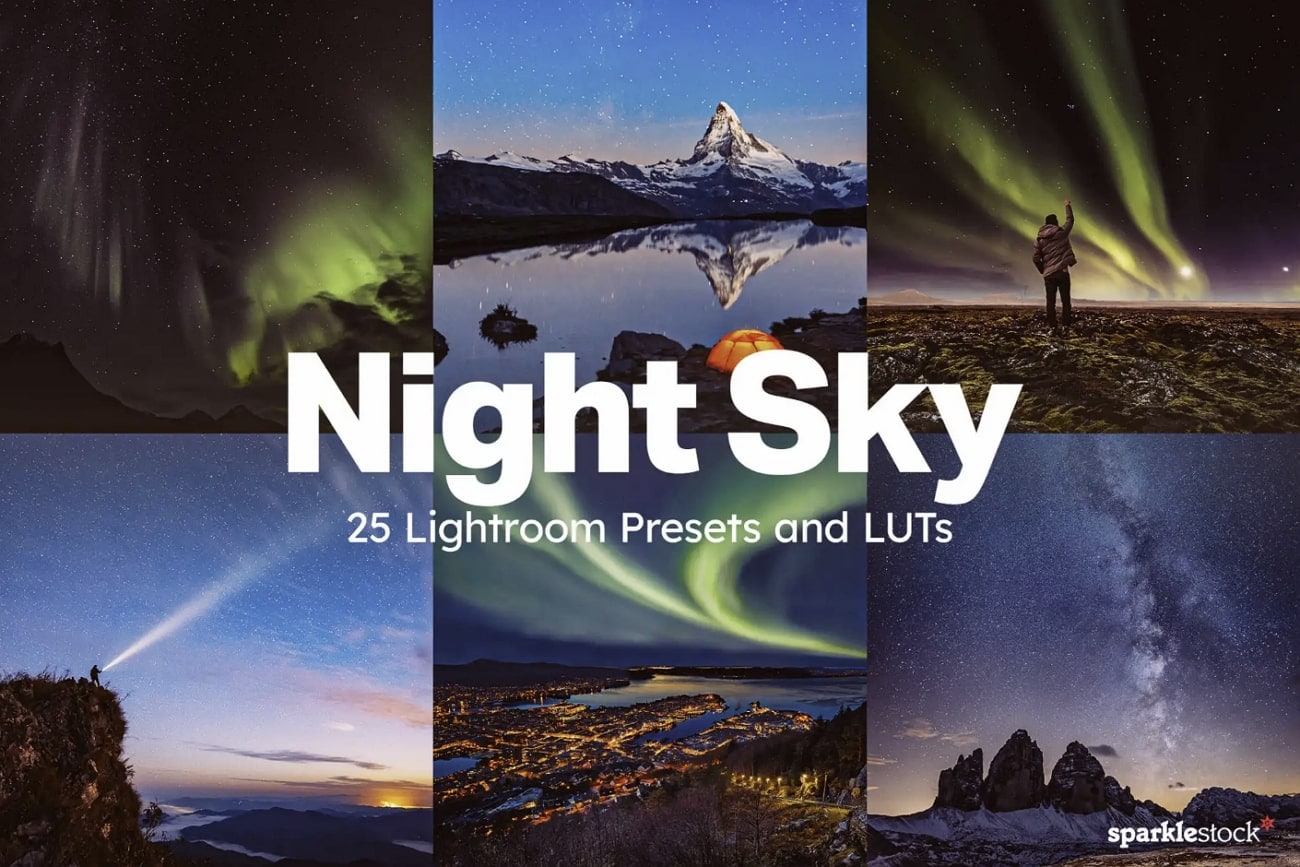
Part 2: Filter for VN - LUTs Presets: A Great Option for LUT Editing in VN Editor
Introducing Filter for VN - LUTs Presets , an exceptional companion app for VN Editor. This companion application is available on Android devices. You can import LUTs directly into your VN Editor for color grading using this app. Furthermore, this app has a collection of over 1000 free LUTs. These LUTs are used as color presets to transform your media in different styles and tones.
Additionally, this app offers different LUTs for the night sky, cinematic look, and more. Similarly, there are many cinematic LUTs for VN video editing that you can use. Moreover, you can use diverse color filters to bring a fresh perspective to your stories. You can apply and use different color filters using this application. In addition to this, it even offers 4K support, ensuring ultra-high-definition and crisp videos.
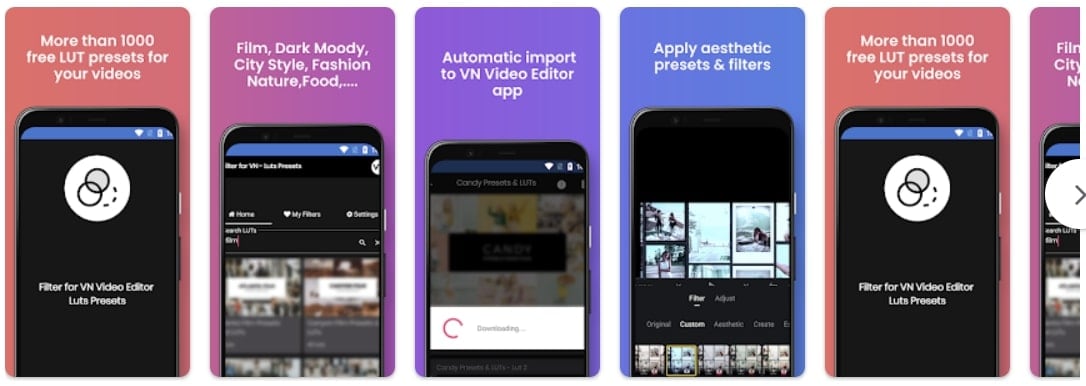
Part 3: How to Add LUTs in VN Editor?
If you want to apply LUTs for VN Editor, then follow these steps. Following these simple steps, you can easily import, apply, and save LUTs using the VN Editor app.
Step1 Importing LUTs
Install the VN Editor and open the app to select the “+” icon, and a new window will appear. From there, you can choose the “Creation Kits” option to select “Filters.” After selecting the Filters option, go to the “My Filter” section. You will see the “Import Filter” button, which allows you to import your LUT from the desired location.

Step2Applying LUTs and Adjusting Intensity
After selecting your desired LUT, your LUT will be imported into the VN Editor. After that, you can find your desired LUT in the “Filters” section. You can select your LUT and apply it to your media file. Adjust the intensity of the LUT according to your preference.
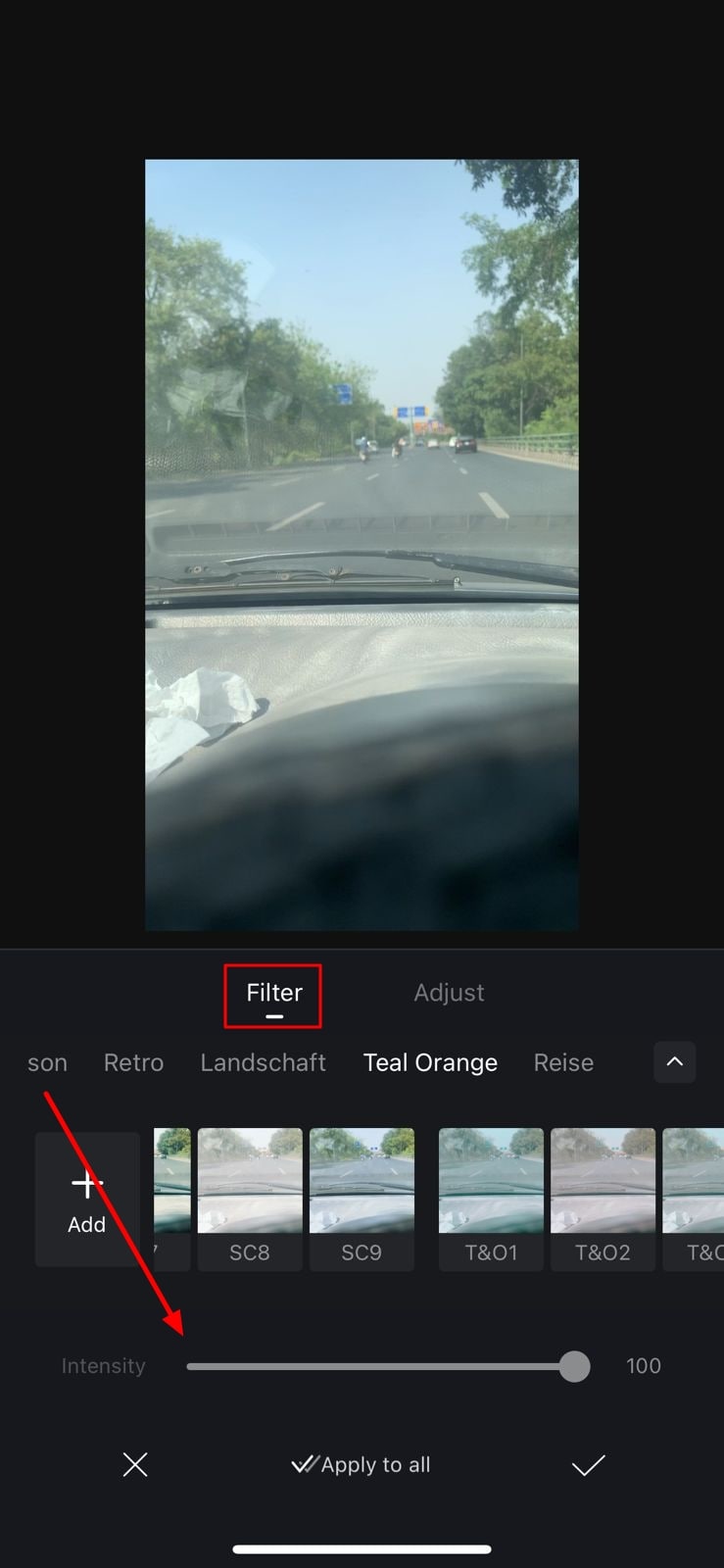
Step3Saving the File
After making your adjustments, tap the “Save” button. Your file will be saved with the applied LUT and your desired modifications.
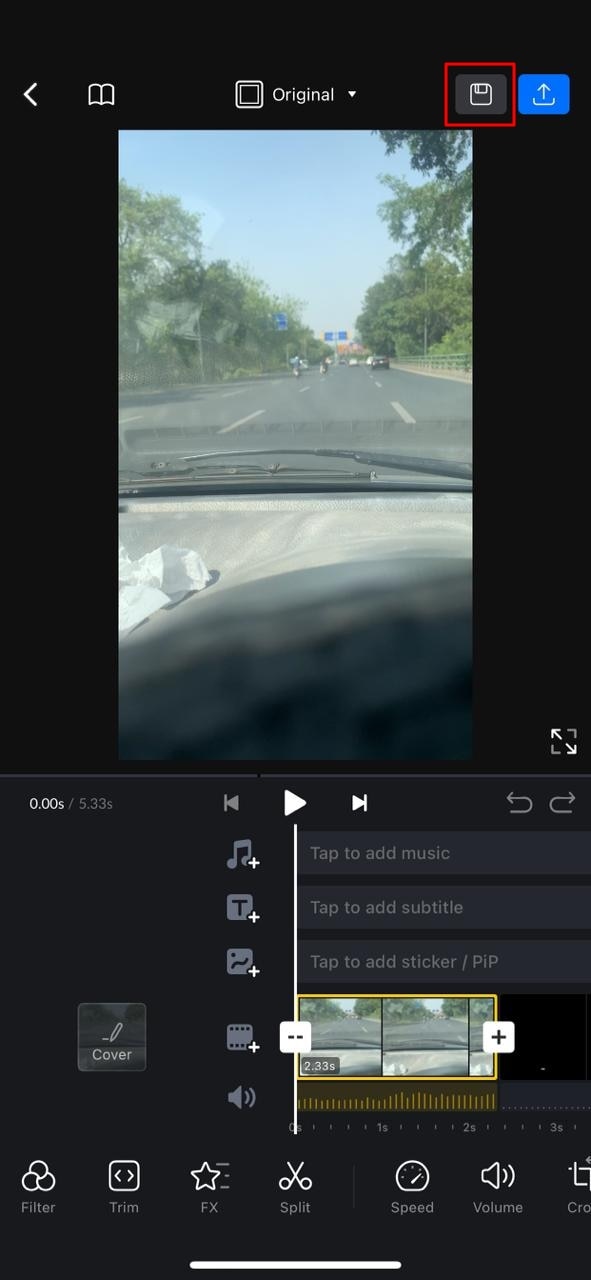
Empower your videos with a new mood using different LUTs. Filmora now offers 100+ top-quality 3D LUTs cover a broad range of scenarios. Transform your videos with Filmora’s powerful 3D LUTs.
Apply LUT on Videos Apply LUT on Videos Learn More

Conclusion
In conclusion, LUTs have proven to be incredibly useful tools on computers for color grading. The availability of different LUTs on the internet has expanded the creative possibilities. The high demand for LUTs resulted in the development of excellent mobile apps, such as VN Editor. Many free LUTs for VN Editor are available, each with different styles and tones, including cinematic and more.
Part 1: Best Options in LUTs That You Can Find in VN Editor?
VN Editor is a great application that allows you to add or apply LUTs. With this tool, you can easily import your LUTs and apply them to your digital media. There are many VN LUTs available, both paid and free. Here is a list of some of the best paid and free LUTs that you can use in VN Editor.
1.Cinematic LUT by Alexey_P
Enhance your videos with the Cinematic LUT, giving them a professional and cinematic look. This LUT adds a touch of cinematic magic to your footage by highlighting rich and deep colors. The warm tones create a cinematic atmosphere, transporting your audience into a movie-like world. Furthermore, this is a suitable LUT pack for shooting a short film or a travel vlog.

2.5 Free Vintage LUTs
You can give your viewers a retro feel with this Vintage LUT pack. This LUT pack brings back the nostalgic charm of old photographs and videos. It provides a soft, warm color palette with desaturation tones, giving your videos a vintage look. Moreover, this pack offers five different vintage LUTs, that you can use for your media files. Additionally, you can recreate an old retro look using these LUTs.

3.Food LUTs
Make your food videos and photography look even more appetizing with this pack. These LUTs enhance your food’s colors, making them vibrant and mouthwatering. Moreover, it brings out the natural hues of the ingredients, making them appear fresh. It is an excellent LUT pack, from showcasing culinary creations to sharing recipes or running a food blog.

4. Moody Video LUTs
Moody LUTs is an amazing color preset pack of 15 to create a moody and dramatic atmosphere. You can use this pack to add deep contrasts, shadows, and cool tones to your videos. In addition to this, it creates a sense of mystery and intensity with its color grading. It’s perfect for storytelling, fashion shoots, or adding a touch of drama to your media content.

5. Night Sky Lightroom Presets and LUTs
It is an incredible color preset and LUTs pack to enhance the beauty of the night sky. This pack offers 10 LUTs for free and 25 LUTs in the paid version. It intensifies the greens, blues and adds a subtle glow to your digital media. Additionally, you can transform ordinary nighttime media into breathtaking moments. This pack will beautify your night sky by highlighting the details and enhancing the color tones.

Part 2: Filter for VN - LUTs Presets: A Great Option for LUT Editing in VN Editor
Introducing Filter for VN - LUTs Presets , an exceptional companion app for VN Editor. This companion application is available on Android devices. You can import LUTs directly into your VN Editor for color grading using this app. Furthermore, this app has a collection of over 1000 free LUTs. These LUTs are used as color presets to transform your media in different styles and tones.
Additionally, this app offers different LUTs for the night sky, cinematic look, and more. Similarly, there are many cinematic LUTs for VN video editing that you can use. Moreover, you can use diverse color filters to bring a fresh perspective to your stories. You can apply and use different color filters using this application. In addition to this, it even offers 4K support, ensuring ultra-high-definition and crisp videos.

Part 3: How to Add LUTs in VN Editor?
If you want to apply LUTs for VN Editor, then follow these steps. Following these simple steps, you can easily import, apply, and save LUTs using the VN Editor app.
Step1 Importing LUTs
Install the VN Editor and open the app to select the “+” icon, and a new window will appear. From there, you can choose the “Creation Kits” option to select “Filters.” After selecting the Filters option, go to the “My Filter” section. You will see the “Import Filter” button, which allows you to import your LUT from the desired location.

Step2Applying LUTs and Adjusting Intensity
After selecting your desired LUT, your LUT will be imported into the VN Editor. After that, you can find your desired LUT in the “Filters” section. You can select your LUT and apply it to your media file. Adjust the intensity of the LUT according to your preference.

Step3Saving the File
After making your adjustments, tap the “Save” button. Your file will be saved with the applied LUT and your desired modifications.

Empower your videos with a new mood using different LUTs. Filmora now offers 100+ top-quality 3D LUTs cover a broad range of scenarios. Transform your videos with Filmora’s powerful 3D LUTs.
Apply LUT on Videos Apply LUT on Videos Learn More

Conclusion
In conclusion, LUTs have proven to be incredibly useful tools on computers for color grading. The availability of different LUTs on the internet has expanded the creative possibilities. The high demand for LUTs resulted in the development of excellent mobile apps, such as VN Editor. Many free LUTs for VN Editor are available, each with different styles and tones, including cinematic and more.
Elevate Your Designs with Feather Shapes in After Effects
Feathering shapes in After Effects can greatly enhance your designs’ overall look and feel. This technique involves creating a soft, blurred edge around the shapes, which adds a sense of depth and dimension. Whether you’re a beginner or an experienced After Effects user, understanding how to feather shapes is a valuable skill to have in your arsenal.
This guide will cover everything you need about feathering shapes in After Effects. From the basics to advanced techniques, you’ll learn how to add a professional touch to your designs and take your skills to the next level.
Whether you’re creating a logo, animation, or visual effect, the ability to feather shapes will help you achieve the desired look and feel for your project. So, let’s dive in and explore the world of feathering in After Effects!
What Is Mask Edge Feather in After Effects?
Mask Edge Feather in After Effects is a feature that enables you to create a soft or blurred transition between the masked and unmasked areas of your composition. The mask feather setting can be found in the properties and is measured in pixels. Increasing the feather value increases the softness or blurriness of the mask’s edges, creating a smoother transition between the masked and unmasked parts of the image.
One of the key benefits of feathering masks is that it allows you to blend the masked object with its background, making the effect look more natural and convincing. The mask feather tool can also create custom feather shapes anywhere along the edge of the mask. To access the mask feather tool, switch to the pen tool by pressing the “G“ key and selecting the feather pen.
The mask edge feather feature in After Effects is a powerful and versatile tool that can help you achieve a wide range of creative effects. Whether you’re creating an animation or visual effect, or want to add a professional touch to your designs, understanding how to use the mask feather tool is an essential skill in your After Effects toolkit.
How To Feather a Shape in After Effects?
Feathering a shape in After Effects is a simple process that can greatly enhance the look and feel of your designs. By following these steps, you’ll be able to easily feather shapes in After Effects and add a professional touch to your designs.
Keep in mind that the feather value can be adjusted to your preference and the needs of your project, so feel free to experiment and see what works best for you.
There are two options to feather the edge in After Effects:
A. Adding a Mask to Shape Layer
Step1 Add a mask to create a feathered edge.
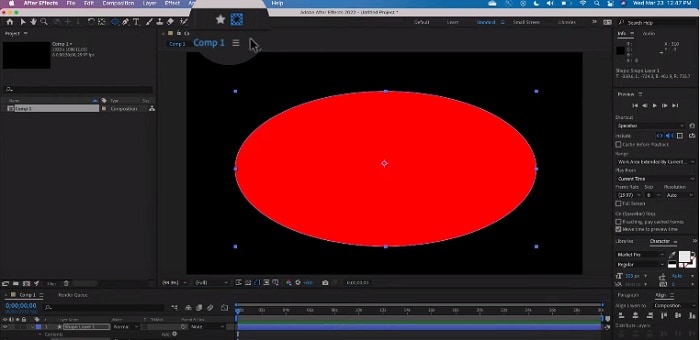
Step2 Edit the feather parameter under the mask in the composition panel.

B. Applying Fast Box Blur Effect
Step1 Go to the “Effects and Preset“ tab and search for the “Fast Box Blur“ effect.
Step2 Increase the “Blur Radius“ to see the edges feather.
How To Use Variable Mask Feather in After Effects?
Variable mask feather in After Effects allows you to create masks with variable feathering. It means you can have different feather values for different parts of the same mask. This feature gives you greater control and flexibility over your masks, allowing you to easily create complex effects and transitions.
With variable mask feathers, you can create complex effects, such as a shape that feathers more in one direction than the other. Or you can create a mask with a soft transition in one area and a hard transition in another.
By experimenting with different feather values and mask shapes, you can achieve a wide range of creative effects in After Effects. To use variable mask feather in After Effects, you’ll need to follow these steps:
Step1 Use the pen tool to create corner points.
Step2 Create the Mask Feather points.
Step3 Adjust the Feather Parameter.
Step4 Go to “Pen Tool“ > “Mask Feather Tool“ and click anywhere on the mask path.
Step5 Drag the mask point feathering around the focus.
This tutorial came from Crish Design . For more tutorials about After Effects tips and techniques, you can refer to the Crish Design YouTube channel.
Need an Alternative? Try Wondershare Filmora
If you’re looking for a more accessible and user-friendly alternative to After Effects, consider using Wondershare Filmora . Filmora is a powerful video editing software that offers many of the same features as After Effects, including an edge feather feature that’s a great alternative to the mask edge feather in After Effects.
Free Download For Win 7 or later(64-bit)
Free Download For macOS 10.14 or later
The edge feather in Filmora is known as the “Blur Strength” and can be found in the “Masks” tab of the editor. Like the mask edge feather in After Effects, the Blur Strength in Filmora is measured in pixels and determines the softness or blurriness of the edges of the mask.

Filmora also offers a wide range of other features that make it a great choice for video editings, such as a user-friendly interface, an extensive library of special effects, and support for multiple file formats. Whether you’re a beginner or an experienced editor, Filmora has everything you need to create professional-quality videos.
So, if you’re looking for an alternative to After Effects that’s easier to use and more accessible, consider giving Wondershare Filmora a try. Its powerful edge-feature feature and user-friendly interface make it the perfect choice for creating professional-quality videos without the hassle of using complex and time-consuming software.
How To Use Shape Feather Tool in Wondershare Filmora?
The Shape Feather Tool in Wondershare Filmora is a great way to create a soft, gradual transition between different shapes in your video. This tool can be used to create a variety of effects, from gentle fades to complex animations.
Whether creating a simple animation or a complex visual effect, this tool gives you the control and flexibility you need to create professional-quality videos. To use the Shape Feather Tool in Filmora, follow these steps:
Step1 Open Wondershare Filmora and create a new project. Import the video and drag it to the timeline.

Step2 Double-click the video in the Player Window. In the editing window, click “Video“> “Mask“ and add a shape mask.
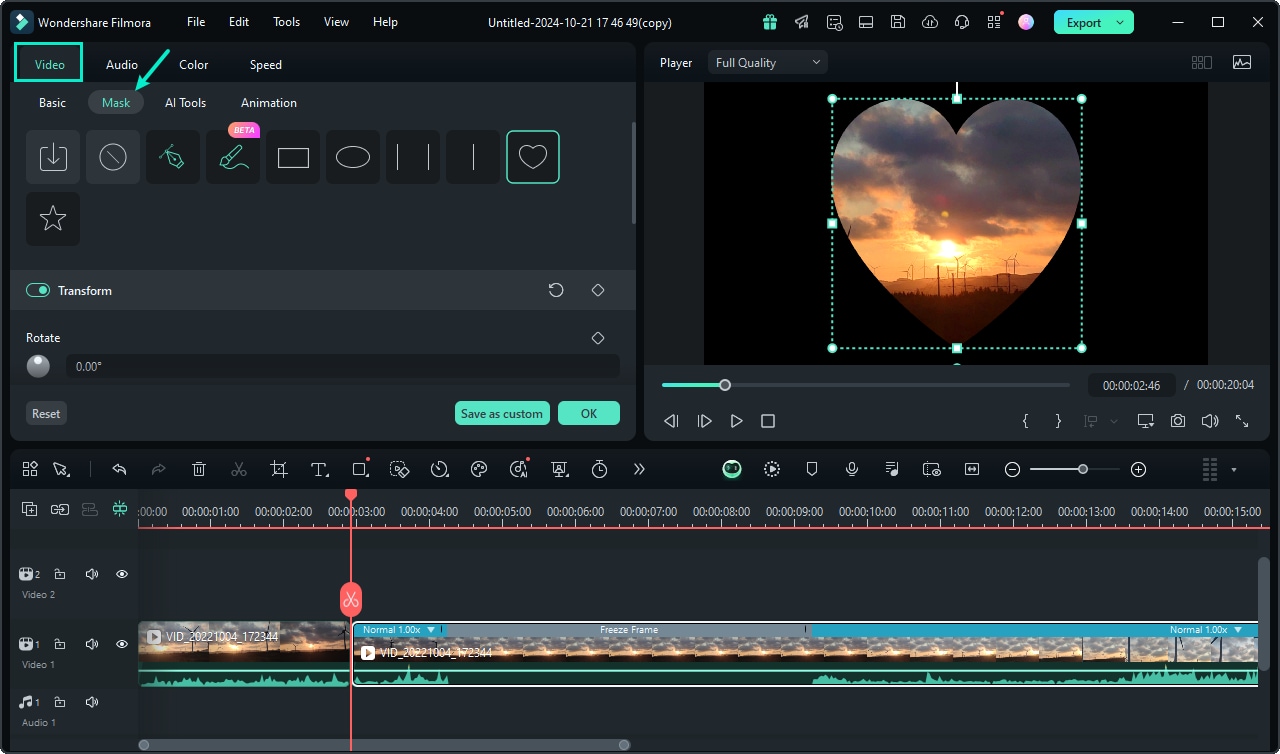
Step3 Scroll down to find the “Blur Strength“ option, and adjust the blur value.
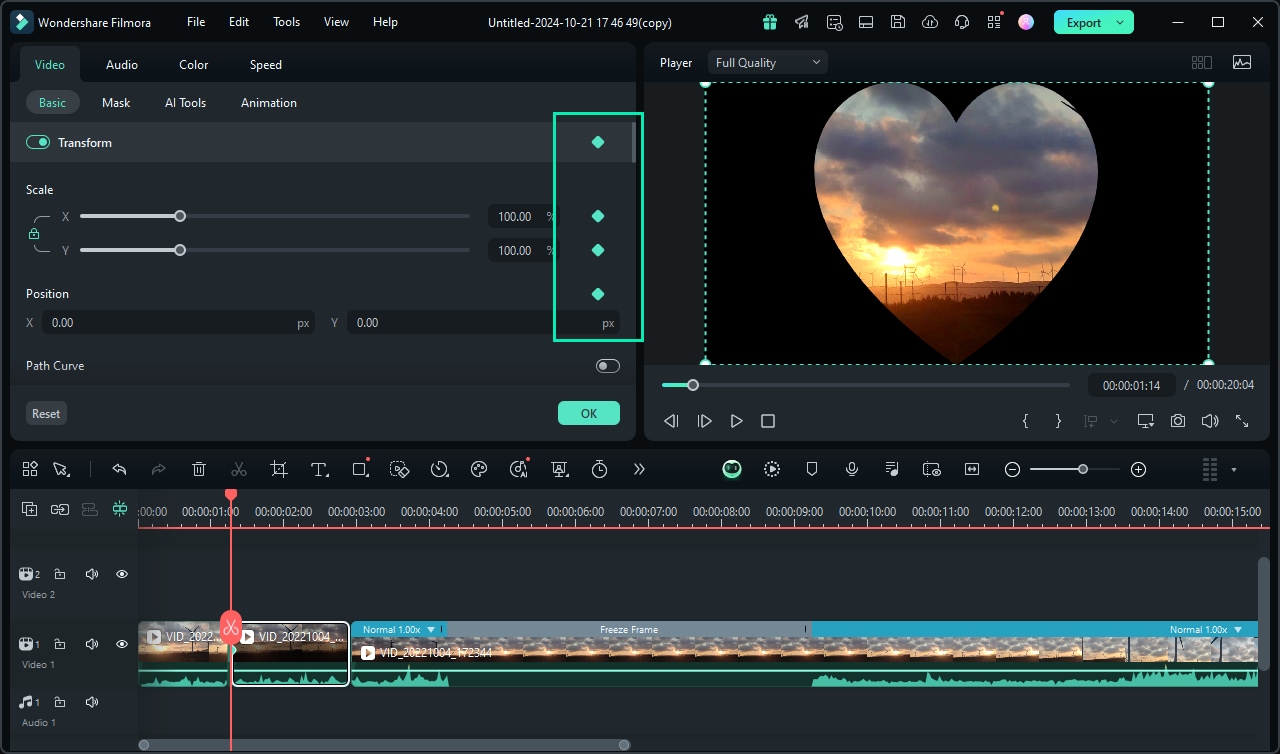
How To Use Variable Mask Feather in Wondershare Filmora?
Wondershare Filmora also allows you to use variable mask feathers to create a smooth, gradual transition between different parts of your video.
But first, understand the process of using the pen tool. When using the pen tool to draw shapes in Filmora, you can customize the shape and feather to your specifications. To do this, select the pen tool and use it to draw the shape you want. You can adjust the feathering by moving the feathering control points and fine-tuning the Blur Strength in the “Mask“ tab.
To use Variable Mask Feather in Filmora, follow these steps:
Step1 Select the “Draw Mask“ option under the Mask tab, and use the pen tool to draw whatever shape you like in the video.
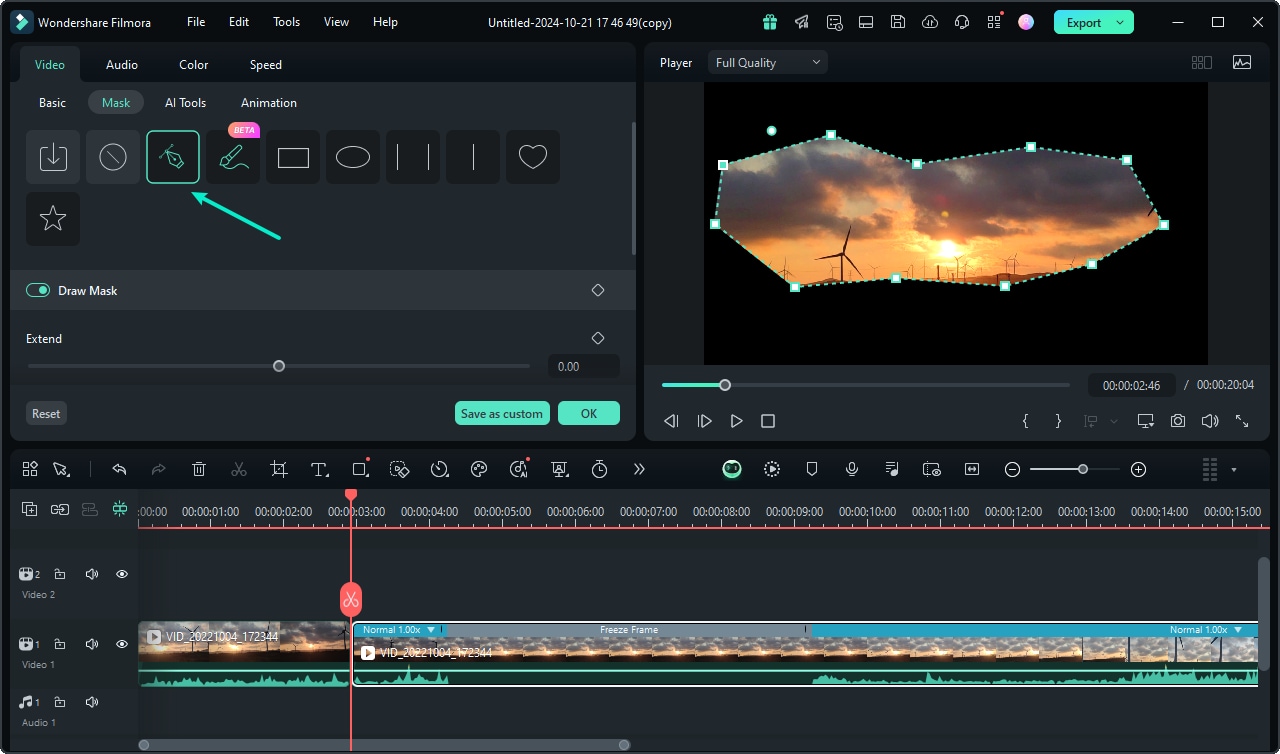
Step2 Adjust the “Blur Strength“ value.

Conclusion
Feathering shapes in After Effects and Wondershare Filmora are powerful tools for creating smooth, seamless transitions in your videos. With the mask feather setting in After Effects and the Shape Feather Tool in Filmora, you have the flexibility and control you need to create the exact look you want.
Whether you’re looking to feather shapes in After Effects or prefer the convenience of using Wondershare Filmora, there’s a solution for you. So why wait? Start feathering your shapes today and bring your video editing skills to the next level!
Free Download For macOS 10.14 or later
The edge feather in Filmora is known as the “Blur Strength” and can be found in the “Masks” tab of the editor. Like the mask edge feather in After Effects, the Blur Strength in Filmora is measured in pixels and determines the softness or blurriness of the edges of the mask.

Filmora also offers a wide range of other features that make it a great choice for video editings, such as a user-friendly interface, an extensive library of special effects, and support for multiple file formats. Whether you’re a beginner or an experienced editor, Filmora has everything you need to create professional-quality videos.
So, if you’re looking for an alternative to After Effects that’s easier to use and more accessible, consider giving Wondershare Filmora a try. Its powerful edge-feature feature and user-friendly interface make it the perfect choice for creating professional-quality videos without the hassle of using complex and time-consuming software.
How To Use Shape Feather Tool in Wondershare Filmora?
The Shape Feather Tool in Wondershare Filmora is a great way to create a soft, gradual transition between different shapes in your video. This tool can be used to create a variety of effects, from gentle fades to complex animations.
Whether creating a simple animation or a complex visual effect, this tool gives you the control and flexibility you need to create professional-quality videos. To use the Shape Feather Tool in Filmora, follow these steps:
Step1 Open Wondershare Filmora and create a new project. Import the video and drag it to the timeline.

Step2 Double-click the video in the Player Window. In the editing window, click “Video“> “Mask“ and add a shape mask.

Step3 Scroll down to find the “Blur Strength“ option, and adjust the blur value.

How To Use Variable Mask Feather in Wondershare Filmora?
Wondershare Filmora also allows you to use variable mask feathers to create a smooth, gradual transition between different parts of your video.
But first, understand the process of using the pen tool. When using the pen tool to draw shapes in Filmora, you can customize the shape and feather to your specifications. To do this, select the pen tool and use it to draw the shape you want. You can adjust the feathering by moving the feathering control points and fine-tuning the Blur Strength in the “Mask“ tab.
To use Variable Mask Feather in Filmora, follow these steps:
Step1 Select the “Draw Mask“ option under the Mask tab, and use the pen tool to draw whatever shape you like in the video.

Step2 Adjust the “Blur Strength“ value.

Conclusion
Feathering shapes in After Effects and Wondershare Filmora are powerful tools for creating smooth, seamless transitions in your videos. With the mask feather setting in After Effects and the Shape Feather Tool in Filmora, you have the flexibility and control you need to create the exact look you want.
Whether you’re looking to feather shapes in After Effects or prefer the convenience of using Wondershare Filmora, there’s a solution for you. So why wait? Start feathering your shapes today and bring your video editing skills to the next level!
Also read:
- Updated 2024 Approved Best 10 Fun Discord Bots You Need
- New In 2024, Fixing The Slow Playback Issues in DaVinci Resolve
- New This Article Talks About Pixel Art Wallpapers. It Gives Examples of Different Pixel Art to Show You How to Customize Your Own Pixel Art Wallpapers, and How to Make a Pixel Art Gif on Filmora
- New How to Rotate Video in iMovie with Alternative
- New Top Free LUTs To Use in Shotcut An Overview for 2024
- 2024 Approved Guaranteed 10 Storyboard Creators To Make Animation Easier For You
- New Top 9 AMV Makers for Computer
- How I Got Free After Effects Templates Slideshow with Simple Trick
- Updated How to Apply Gaussian Blur Effect to Videos In Premiere Pro, In 2024
- New Do You Know There Are Websites to Download Free Glitch Transition Effects for Premiere Pro? You Can Easily Download Them and Make Awesome Videos
- New 10 Top Vloggers on YouTube for 2024
- 2024 Approved Unlink Audio and Video in DaVinci Resolve Detailed Steps
- New Progressive Solutions to Adding VHS Effects to Video with Ease for 2024
- Best 20 Slideshow Makers for Win/Mac/Online Review
- Updated In 2024, How to Create a Slideshow with Icecream Slideshow Maker
- New 2024 Approved 4 Methods to Crop a Video on Android Easily
- New In 2024, End Screen Makers
- Updated You May Want to Create Your Video Tutorial and Share Your Knowledge with Others. Fortunately, You Can Easily Create a Professionally Edited Tutorial Video with Filmora. Keep Reading This Article Since We Will Show You How to Do It
- Updated Guide To Using Luts Perfectly in Final Cut Pro for 2024
- New Do You Seek to Blur Out Your Video and Photo to Display some Motion Blur? This Article Provides a List of the Best Motion Blur Apps for Videos and Photos
- Updated Want to Add Freeze Frame Effect to Your Video on Your Device? Here Are the Steps to Add Freeze Frame on PC, Mac, Smartphone as Well as Online From Any Device
- Best Cinematic LUTs For Premiere Pro Recommendation
- Top Fixes to Resolve Issues with Premiere Pro Slow Playback for 2024
- Updated 2024 Approved How to Make After Effects Gifs
- New Do You Want to Know Where You Can Find Online Video Editing Courses? In This Article, We Have Provided 15 Options for Your Various Demand. We Also Recommend a Great Video Editor to Help You Start Your Video Editing Journey with Ease
- Tutorial | How to Make a Smooth Speed Ramping in Premiere Pro, In 2024
- New In 2024, How To Add Motion Blur Effect To Photos in GIMP
- New Do You Want to Know About Efficient Motion Blur Plugins for Adobe Effects? Read This Article to Find Out How to Use Motion Blur Plugins for Enhanced Results
- New In 2024, | Top GIF to MP4 Converters
- New 2024 Approved Best Applications That Can Help Apply The Best VHS Camera Effect
- How to Create a Special Animated Transition in Filmora in Just 2 Minutes. This Simple Step-by-Step Guide Will Show You the Easy Way
- In 2024, Beginners Guide About WMV Format and Best WMV Video Editor
- 2024 Approved Guide To Creating the Best Video Collages
- New How to Make a Slideshow with Icecream Slideshow Maker
- New In 2024, Things You Need to Know About Transparent PNG Remove and Convert
- Updated 2024 Approved A Guide to Effective Video Marketing
- Updated 2024 Approved All About GIF Keyboard That You May Want to Know
- In 2024, How to Make Dynamic Video Collages?
- Updated 2024 Approved How to Make a Vacation Slideshow in 5 Minutes
- How to Make Strobe Light Text Effect, In 2024
- Updated How to Make Dynamic Video Collages?
- Updated In 2024, How to Rotate Videos With Media Player Classic
- New Browse the List of the Best 8 Scanners or Converters for Converting the Slides to Digital Images. Also, Know the Other Important Information of Slides to Digital Conversion
- Updated Guide to Add Transition Effects in Premiere Pro for 2024
- 2024 Approved How To Cut Videos For Instagram On Mac
- New How to Create Datamoshing Effect to Your Footage in After Effects for 2024
- 2024 Approved This Article Will Show You How to Make a Tattoo Disappear on Your Body Magically
- Updated Create Motion Effect with Path Blur In Photoshop for 2024
- Unlocking Apple iPhone 6s Plus Lock Screen 3 Foolproof Methods that Actually Work | Dr.fone
- How to Find iSpoofer Pro Activation Key On Xiaomi Redmi 12 5G? | Dr.fone
- Why are your photos lost from iPhone 13 Pro Max? | Stellar
- 5 Quick Methods to Bypass Tecno Spark Go (2023) FRP
- How do i add my signature to .dotx file
- 4 Feasible Ways to Fake Location on Facebook For your Infinix Hot 30i | Dr.fone
- iSpoofer is not working On Nokia C12? Fixed | Dr.fone
- The Updated Method to Bypass Samsung Galaxy S24 Ultra FRP
- How To Pause Life360 Location Sharing For Realme Narzo N53 | Dr.fone
- In 2024, Easy Guide How To Bypass Xiaomi 14 FRP Android 10/11/12/13
- Undelete lost messages from Infinix GT 10 Pro
- In 2024, The Updated Method to Bypass Nokia C32 FRP
- Updated 2024 Approved Finest Text-to-Speech Male Voice Tools for Natural Output
- In 2024, 3 Things You Must Know about Fake Snapchat Location On Vivo Y55s 5G (2023) | Dr.fone
- How to Mirror PC Screen to Vivo Y100i Power 5G Phones? | Dr.fone
- How to Turn Off Google Location to Stop Tracking You on Lava Blaze Curve 5G | Dr.fone
- How To Transfer WhatsApp From Apple iPhone 15 Plus to Android/iOS? | Dr.fone
- All About Factory Reset, What Is It and What It Does to Your Infinix Note 30 Pro? | Dr.fone
- In 2024, How Can We Bypass OnePlus Ace 2 FRP?
- Complete Guide For Apple iPhone 8 Plus Lock Screen | Dr.fone
- 11 Best Location Changers for Lava Yuva 3 Pro | Dr.fone
- Is your OnePlus Open working too slow? Heres how you can hard reset it | Dr.fone
- In 2024, Turning Off Two Factor Authentication From Apple iPhone 14? 5 Tips You Must Know
- In 2024, How PGSharp Save You from Ban While Spoofing Pokemon Go On Oppo Reno 11 5G? | Dr.fone
- How Can I Unlock My Apple iPhone 11 Pro Max After Forgetting my PIN Code? | Dr.fone
- Here Are Some Reliable Ways to Get Pokemon Go Friend Codes For Nokia G310 | Dr.fone
- In 2024, How To Activate and Use Life360 Ghost Mode On Samsung Galaxy A34 5G | Dr.fone
- In 2024, Detailed guide of ispoofer for pogo installation On Honor 90 | Dr.fone
- In 2024, How Can Realme GT 5Mirror Share to PC? | Dr.fone
- How to Unlock Samsung Galaxy M34 Phone Password Without Factory Reset?
- Disabling Apple iPhone 13 mini Parental Restrictions With/Without Password
- How Do I Stop Someone From Tracking My Motorola Razr 40 Ultra? | Dr.fone
- Can Life360 Track Or See Text Messages? What Can You Do with Life360 On Honor V Purse? | Dr.fone
- Updated The Ultimate Guide to B2B Video Marketing for 2024
- In 2024, Hassle-Free Ways to Remove FRP Lock from Honor 90 Phones with/without a PC
- How to restore wiped call history on Samsung Galaxy M54 5G?
- What to do if iPhone 6s Plus is not listed when I run the software? | Stellar
- Identify missing or malfunctioning hardware drivers with Windows Device Manager in Windows 11 & 10
- How can I get more stardust in pokemon go On OnePlus Nord CE 3 5G? | Dr.fone
- 7 Fixes for Unfortunately, Phone Has Stopped on Vivo Y55s 5G (2023) | Dr.fone
- How to use iSpoofer on Realme Narzo 60 5G? | Dr.fone
- In 2024, 5 Ways To Teach You To Transfer Files from Realme Narzo 60x 5G to Other Android Devices Easily | Dr.fone
- Lava Data Retrieval tool – restore lost data from Lava Blaze Pro 5G
- In 2024, How to Screen Mirroring Motorola Moto G13? | Dr.fone
- Xiaomi Redmi Note 12T Pro Unlock Tool - Remove android phone password, PIN, Pattern and fingerprint
- Title: Powerpoint Supported Video Format and Advanced User Tips for 2024
- Author: Chloe
- Created at : 2024-04-24 07:08:14
- Updated at : 2024-04-25 07:08:14
- Link: https://ai-editing-video.techidaily.com/powerpoint-supported-video-format-and-advanced-user-tips-for-2024/
- License: This work is licensed under CC BY-NC-SA 4.0.










